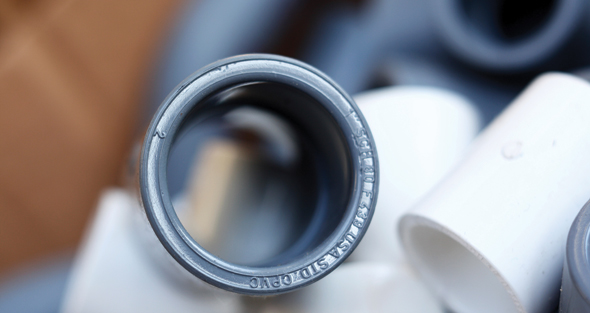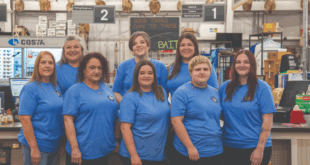While many plumbing sales are triggered by general home maintenance and repair projects, that doesn’t mean retailers can’t find ways to drive additional sales in the category.
With recent legislative mandates regarding water conservation, as well as water safety and health concerns affecting the plumbing category, there are several angles retailers can use to sell their customers on product upgrades and repair parts in this category.
In this story, we’ll focus on four key trends affecting the plumbing category today and how two retailers are working with their employees to increase plumbing sales at their stores. Both have found strong selling points in helping customers find ways to save money and gain confidence in completing d-i-y plumbing projects on their own.
We’ll also offer some ideas of how you can use those trends to educate your employees about how you can increase transaction sizes in your plumbing department.
D-I-Y Friendly
With changes in the economy in the past few years, experts say more consumers are opting to tackle their own plumbing projects instead of hiring them out. As a result, many retailers who used to report strong sales from contractors say that more business is being replaced by do-it-yourselfers than in the past.
That’s been the case for Gregg Kirksey, plumbing buyer for Scarborough Lumber in Ben Lomond, Calif. Prior to 2008, contractors drove 70 percent of sales in plumbing, the store’s second-largest department. Today, the plumbing department caters to DIYers, and the store’s layout reflects that.
“Our plumbing department starts at the back left toward the center of the store, and products are organized around how customers would typically build their projects. The first aisle has ABS and PVC fittings. The next aisle over is toilet repair, then next is faucet and faucet repair,” he says. “Lengths of pipes are outdoors, which we can cut to size, and customers can go inside to pay.”
With the rise of d-i-y sales in plumbing has also come an increased demand of PEX products and push-fit type fittings, which are designed to make it easy to connect two pieces of pipe without gluing or soldering.
Jack Edelstein of Crown Hardware and Plumbing Supply in Milwaukee has noticed an uptick in customer interest in solderless and flexible gas fittings in his market, which is predominately comprised of DIYers.
How to Sell It
Know how to troubleshoot. Identify the most common repair projects and make sure everyone on staff can troubleshoot and walk customers through a repair. Consumers are more likely to repair than to replace when it comes to plumbing fixtures, for example, so train staff on how to identify replacement parts for these projects.
Get to the root of the problem. While employees will know projects inside and out, they should also have patience for those customers who may not know exactly what they want or need to complete a project.
Crown Hardware has this concept down. The store’s plumbing department is set up with a counter where customers wait in line and employees talk to them through the sale to find out what products to pull from the store’s back room for the customer’s project. The store’s plumbing inventory is large—Crown Hardware stocks 10,000 products on-site and also offers special ordering for those harder-to-find items—so this one-on-one service model saves customers from having to search for an item themselves.
“This setup forces customer interaction, leading to more add-on sales and closer customer relationships,” Edelstein says. “We know the right questions to ask before we proceed with the sale.”
Offer customer training. Have a customer base interested in d-i-y plumbing repair? If it’s not feasible to offer a plumbing repair workshop in your store, consider partnering with a local trade school that offers adult learning courses in basic plumbing maintenance. Ask if the instructor can hand out coupons to offer students a discount at your store on the plumbing supplies they’ll need to complete the projects in their own homes.
Water Conservation and Reclamation
 Especially in areas of the country with drier climates, consumers are more conscious than ever about water conservation, and it’s becoming part of a larger, national trend.
Especially in areas of the country with drier climates, consumers are more conscious than ever about water conservation, and it’s becoming part of a larger, national trend.
Products with a focus on water conservation have been big sellers recently at Kirksey’s store. “We’ve been shifting over to low-flow toilets and showerheads and also offer dual-flow retro-fits for toilets,” he says. “Here, it’s all about the water.”
No matter the weather conditions in your market, eco-conscious products such as
low-flow showerheads and water-saving toilets are still big sellers across the country with green consumers.
And in some cases, it’s the law for retailers to sell them. California, Texas and Georgia and some counties in other states already mandate that all new toilets sold use 1.28 gallons per flush; currently the standard nationwide is 1.6 gallons per flush. Some experts in the plumbing industry predict these laws may become part of a larger, national directive within the next few years.
How to Sell It
 Know when to bring in new inventory. When it comes to deciding what to stock in your plumbing category, it’s important to study your market and keep up to date on local and state laws.
Know when to bring in new inventory. When it comes to deciding what to stock in your plumbing category, it’s important to study your market and keep up to date on local and state laws.
This is also where you can emphasize to your customers that you can do what the big-box stores can’t: regionalize your product mix. Independents can adjust their product mix more rapidly than the big boxes, so if local codes mandate a specific supply line, you can stock it quickly.
Stay on top of ordering items for popular projects. Because of the dry climate in Kirksey’s market, he says he can’t keep enough d-i-y rain catchments on the shelves.
The same goes for when pipes freeze in the winter in colder areas of the country. Order enough electrical heating tape and other supplies at times when pipes are more prone to freezing.
Keep conservation top-of-mind for customers. Home Depot, for example, has been making a push recently to educate consumers about water conservation with in-store signage, displays and an awareness day. Use your strengths to improve on this idea: Ask a local environmental group to hold a series of conservation workshops in-store.
Energy Efficiency
In 2015, the government is expected to regulate new efficiency standards for electric and gas water heater units, similar to the light bulb regulations that went into effect earlier this year.
Unlike the low-lead pipe mandate that took effect at the beginning of this year, you won’t have to eliminate out-of-date water heaters from your inventory. These new standards just mean manufacturers won’t be able to make units that don’t meet the efficiency standard anymore; retailers will still be able to sell what’s on
their shelves.
For electric water heaters, anything larger than 50 gallons requires a heat pump (a fan unit that takes ambient air and uses it to heat water, making it more efficient in electric units). Gas units will require minimum energy efficiency of 0.93, which means they will have two inches of insulation wrapped around the tank to keep water hotter longer
Additionally, many industry experts predict tankless water heaters may make a comeback as energy efficiency becomes top-of-mind for budget-conscious consumers.
How to Sell It
Explain the benefits. While tankless water heaters save energy, consumers will sometimes balk at the higher up-front investment. Do your research before adding any to your inventory and explain to customers the benefits of tankless water heaters with shelf talkers and signage.
Don’t forget the extras. If you sell tankless water heaters, train your employees on their specialized features. Don’t forget about add-ons—there are many items that can help customers complete installation, such as vent pipes, shut-off valves and more.
Consider offering delivery or on-site service. Consider offering on-site and in-store services or product delivery and setup for larger items such as water heaters to capture all the installation add-on sales. Crown Hardware and Plumbing Supply offers water heater installation, pipe cutting and threading.
If you can’t spare an employee, develop a relationship with local contractors to whom you can refer customers. Keep a list of plumbers you trust both in-store and on your website. A local contractor purchases two-thirds of all the water heaters in Kirksey’s store. “He installs them, and many times customers will call and ask for him,” he says.
Safety and Health
Something your customers likely aren’t thinking about—but should be—when it comes to their health and the plumbing in their homes is the water filtration systems in their refrigerators.
Until recently, these filtration systems were only available from the original appliance manufacturer. Now, more and more manufacturers are making branded versions of these systems for distribution at the retail level.
The good news for retailers is twofold: Refrigerator water filtration systems are not expensive, with prices coming down as more non-original appliance manufacturer replacement parts are becoming available. Additionally, plumbing parts buyers are encouraging consumers to change their water filters twice a year, meaning there’s a big opportunity for you to catch repeat purchases.
How to Sell It
Remind your customers when it’s time to buy. Promote how easy and inexpensive this project is with in-store signage. Then keep track of when customers last purchased a water filter so you can remind them when it’s time to buy a new one with a text alert, email or postcard.
Show customers sometimes it’s just that easy. A diagram showing the basics of this project (and other simple plumbing projects) can help boost customers’ confidence that they can do the project themselves. It also helps your sales associates explain the project.
 Hardware Retailing The Industry's Source for Insights and Information
Hardware Retailing The Industry's Source for Insights and Information








